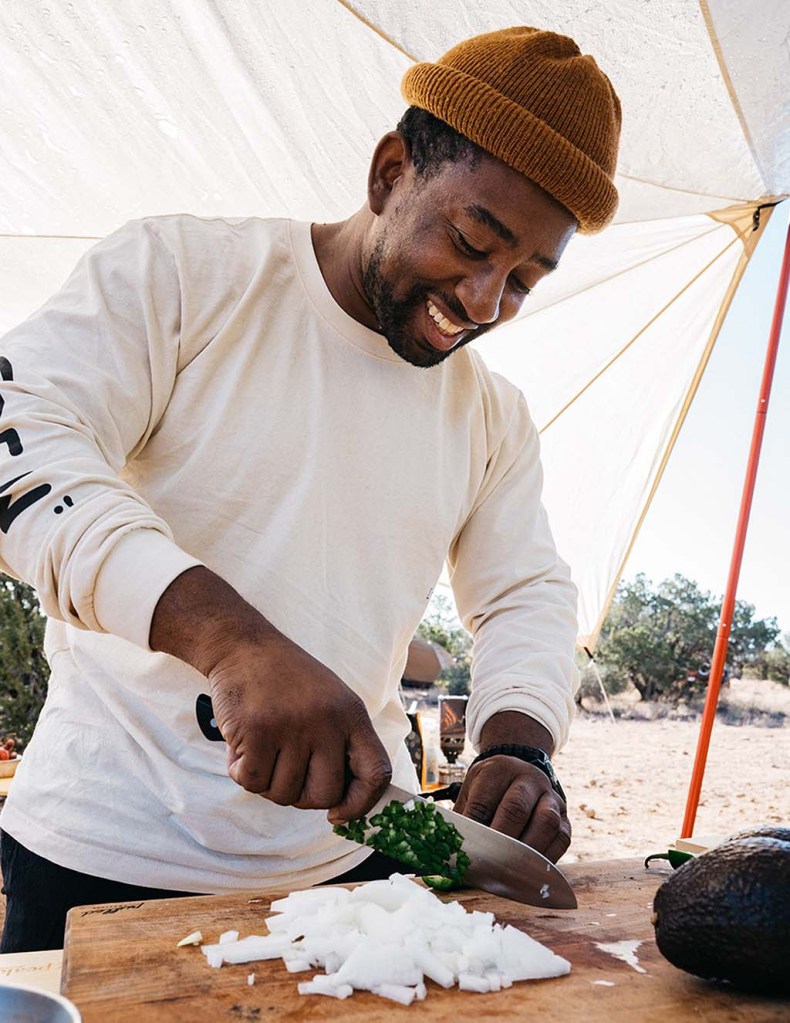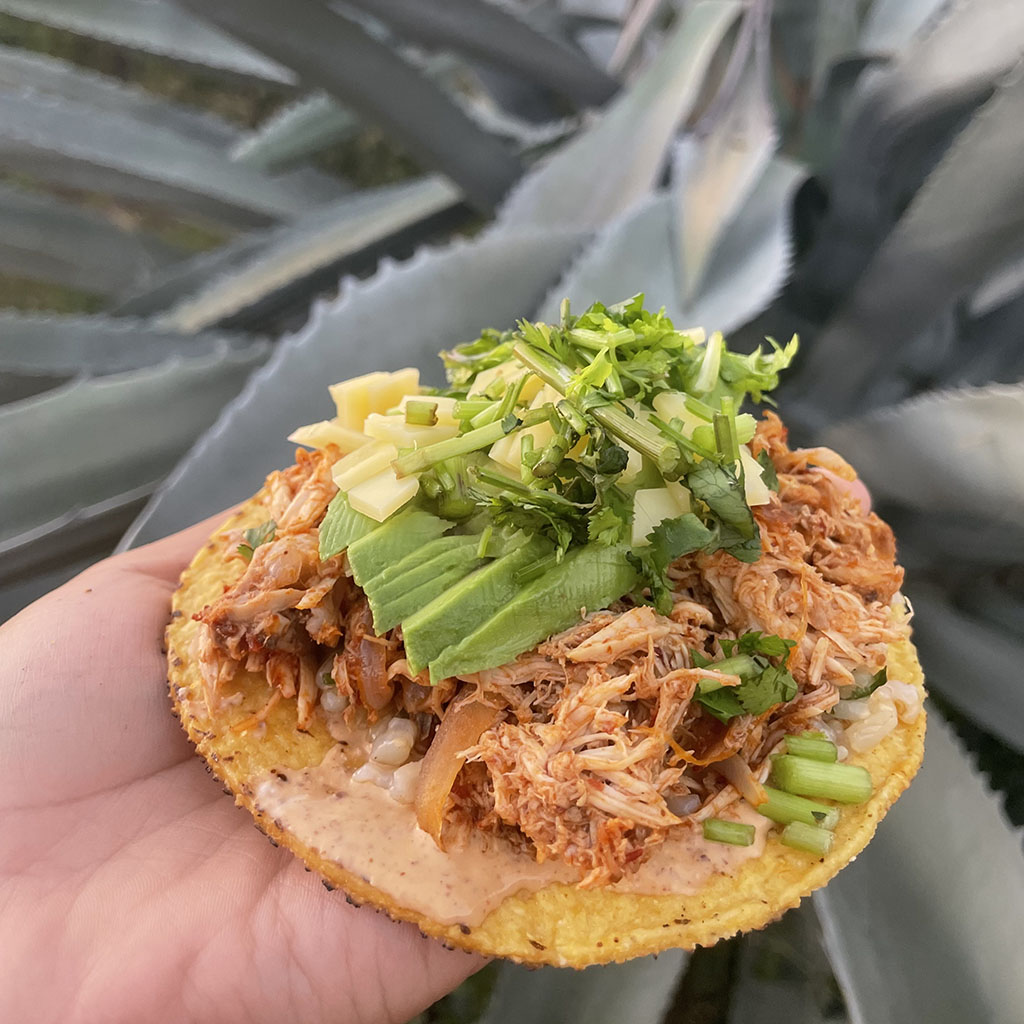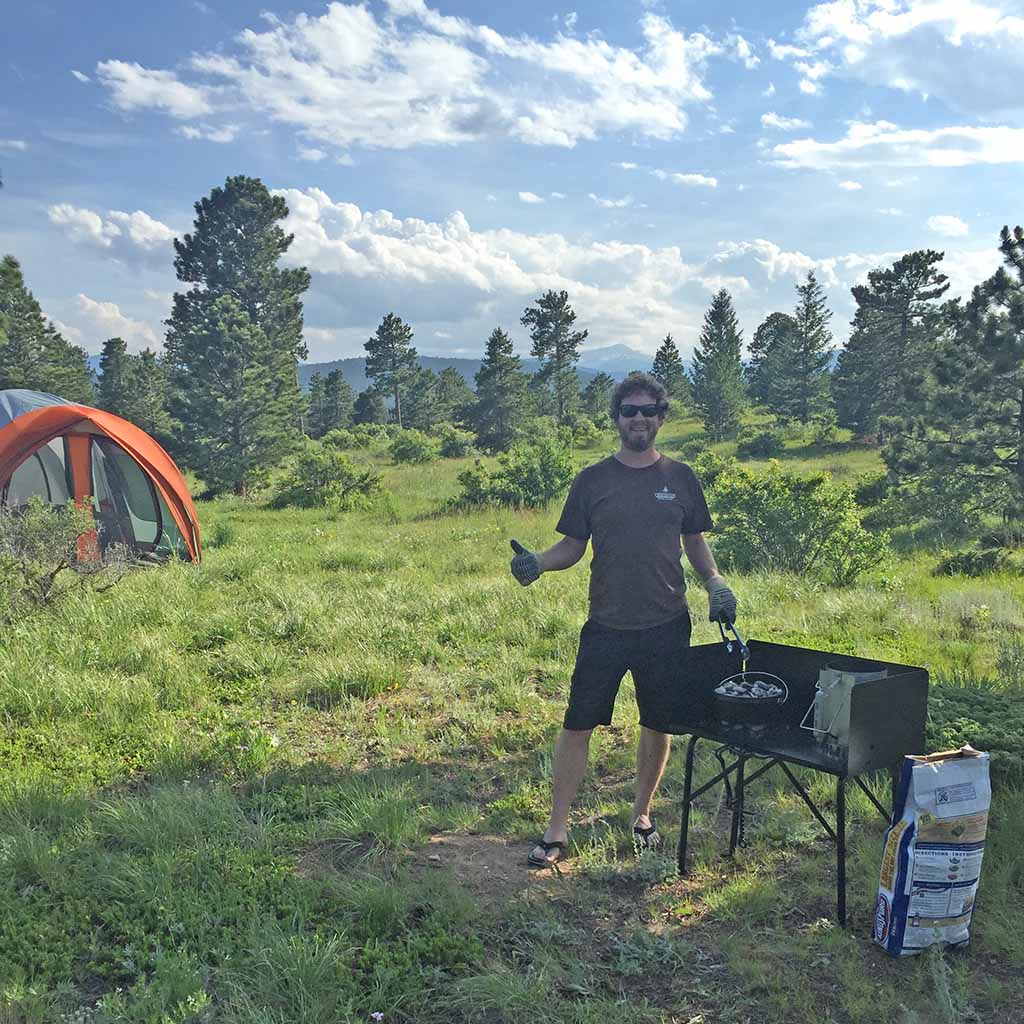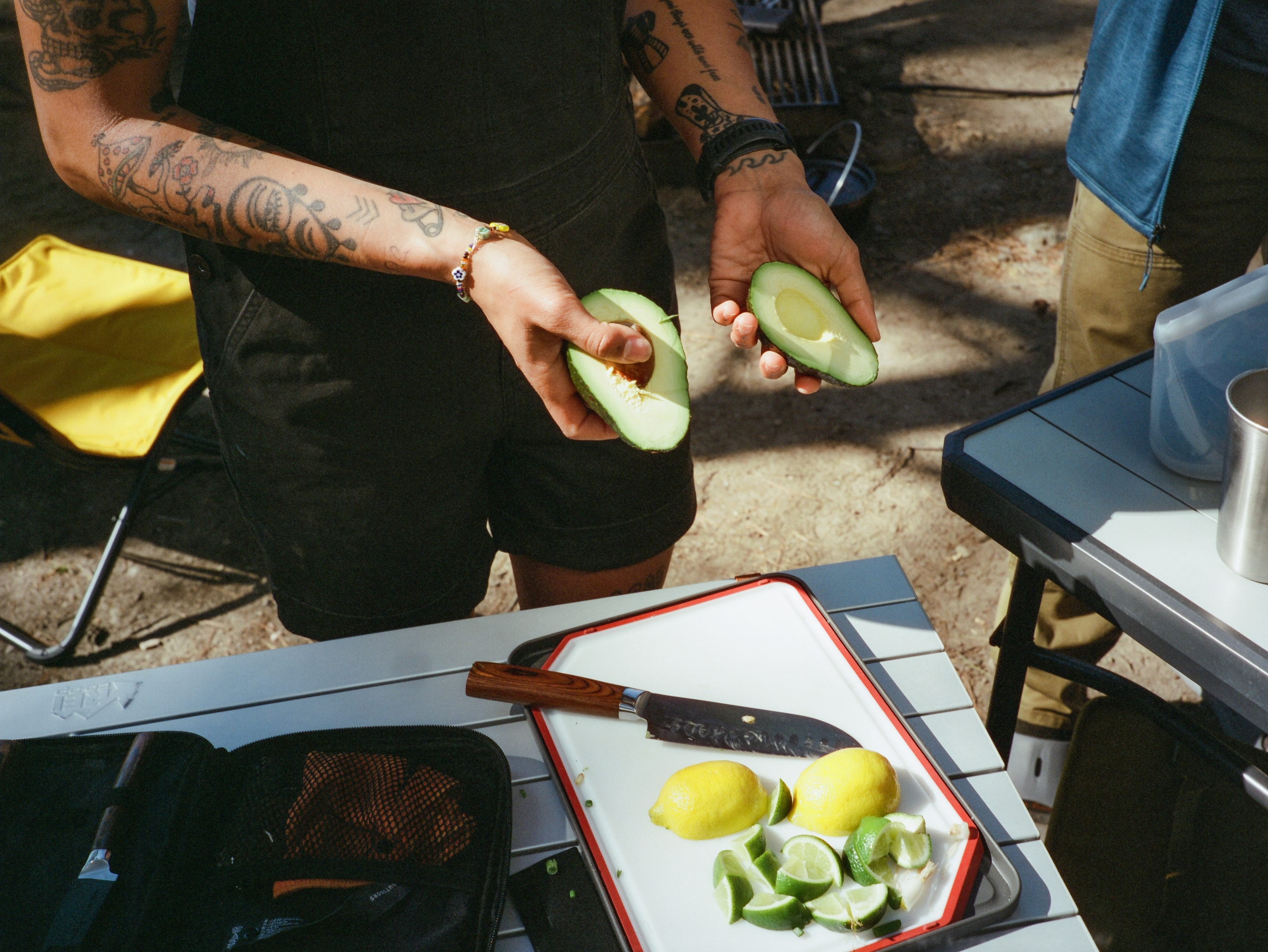Sometimes we go camping to sate a hunger for adventure. Other times, we pack up our tents and camp cooking supplies simply to sate our hunger for good food. After all, food does taste better at camp.
Making a meal in the wilderness can involve techy pots and multi-burner stoves or simply flames and hot coals. The delicious result might be a gourmet taste explosion or a return to ancient lifeways. The experience might go precisely as planned or exactly the opposite. But whatever we fork, spoon or spork into our mouths, there’s no question the food—shared, passed around and enjoyed around the campfire or at a picnic table—will satisfy in more ways than one.
Chef Style
Magenta and coral-hued skies over deep canyons and high peaks are great and all, but Rashad Frazier knows what makes these sights even more memorable: good eats. Formerly a professional chef in Brooklyn, Frazier is co-founder of Portland, Oregon–based adventure company Camp Yoshi which provides digital-detox and wellness escapes for groups and solo travelers alike. He loves nothing more than to guide guests to a stunning lookout point, watch as they take in a vista photos could never fully capture, and then pass around grilled T-bones with confit cherry tomatoes and salsa verde or a tray of tender braised short ribs served over heirloom grits with roasted garlic and smoked sea salt. “If you’re going to go that far out to see something cool and vibey, why would you not want to pair that with an amazing meal and bottle of wine or cocktail?” laughs Frazier, an REI Co-op Member since 2018. “Food is the only thing that matters. I don’t care where you are, if the meal is not good, it will ruin any experience.”
Lousy cooking won’t ruin any experience on Frazier’s watch, especially given his fleet of high-quality cooking vessels and utensils. For even heat distribution and lightweight titanium cook sets he turns to the Takibi Fire & Grill and Micro Pot from Snow Peak, while Dometic coolers (namely the CFX5 75 Dual-Zone Powered and Recon 41 L) keep his thyme fresh, his craft beer cold and his chocolate ganache intact. By pairing quality camp kitchen gear with a food philosophy that centers on fresh, local ingredients (seasonal whenever possible) and not overdoing what nature already made delicious, Frazier keeps morale high among his clients, many of whom are venturing into the outdoors for their first time. “Food is important because people are on vacation,” he says. The one thing that will remind them quickly that they miss home is a lousy meal.”
Food’s most important role, however, is its ability to bring people together, whether on Camp Yoshi Trips to Nowhere or those that we plan with our own friends and family. “How do you get a group to come together quickly?” Frazier asks. “You feed them.”
Learn more about Camp Yoshi with the REI Co-op Studios short film REI Presents: Camp Yoshi.

Grilled T-Bone with Confit Cherry Tomatoes and Salsa Verde
(Serves 2)
Ingredients
Salsa Verde:
- 1 cup parsley, chopped
- 1/2 cup cilantro (optional)
- 1 clove garlic
- 2 anchovy fillets
- Zest plus the juice of 1 lemon
- 1 tsp red wine vinegar
- 1/3 cup olive oil
- Salt and pepper to taste
Confit Cherry Tomatoes:
- 1 pint cherry tomatoes
- 3 cloves garlic, smashed
- 1/2 cup olive oil
- Pinch of chili flakes
T-Bone:
- 1 thick-cut T-bone steak (1 1/4–1 1/2 in. thick)
- Salt and pepper to taste
- Cooking oil
Instructions
At home
- Make the salsa verde: Blend all ingredients until spoonable. Chill in a sealed jar for up to five days.
- Make the confit cherry tomatoes: Toss ingredients and roast in a single layer on a baking sheet at 250°F for 1.5 hours. Tomatoes should be jammy, not burst. Let cool and store in a leak-proof container, both at home and at camp.
At camp
- Choose a cooking setup: An open fire and grill grate produce the best flavor, if there are no fire bans in place. Otherwise, use a cast-iron skillet on a camp stove.
- Pull the steak from the cooler at least 30 minutes before cooking to allow it to come to air temp. Season generously with salt and pepper.
- Heat your fire or stove. Get your dry pan or grill rippin’ hot.
- Sear the steak: If using a grill, sear 4 to 5 minutes per side over high heat. Remove from heat and let it rest for 10 minutes. If using a skillet, add a little oil and sear 3 to 4 minutes per side, beginning with high heat then reducing temperature to medium-high. Optional: Baste with a bit of oil or butter if you’re feeling extra.
- Warm the precooked confit tomatoes: Toss them into a small pan and gently warm through.
- Plate and serve: Slice the steak, spoon on those glossy tomatoes and drizzle generously with salsa verde.
Editor’s note: Look for this recipe and plenty of other tasty delights in Frazier’s upcoming cookbook, Cook Out, publishing in March 2026.
Back to the Elements
Sophia Uribe is familiar with the range of high-tech camp stoves, but she prefers the multifaceted power and beauty of ancient cooking modalities. As a program leader for Native Like Water, an REI Cooperative Action Fund partner that presents outdoor experiences through an Indigenous lens, she often opts for kindling and an open flame over grills and gas. “The fire is a centering space,” says Uribe, an REI Co-op Member since 2021—its warmth, ambiance and aesthetic create something toward which she sees people gravitate. “Being able to have that sense of community while your food is being created, while you’re going to nourish your body, it adds extra magic.”

A Latina woman with Huíchól Indigenous ancestry, Uribe acknowledges that working with the flames—for example, to perfectly simmer the corn, beans and squash in a traditional Three Sisters Soup (La Milpa)—presents some challenges. First, there’s the matter of finding tinder, kindling and firewood; then the process of adding each material in the right order to create a sufficient heat source. (Read more: How to Build a Campfire) To cook effectively, she sources flat rocks to conduct heat and provide a level platform for her cooking vessel. Selecting the right pots and pans initially required some trial and error (Uribe now gravitates toward cast iron because it effectively retains heat), but every time she cooks she must learn about that individual fire, finding hot spots when ingredients must be lightly charred and cooler sections better for roasting.
Uribe contends that the effort is worthwhile. Cooking with fire, she explains, occurs on the ground, bringing her closer to the earth than cooking on a picnic table or stovetop would. In the same vein, using elements from nature (like wood fuel)—instead of synthetic, plastics-based products—creates a relationship with Earth’s bounty. And for Uribe, whose culture uses fire to mark life’s milestones and celebrate seasonal transitions, the flames tether her to something much larger than herself. “Fire engages that practice of returning to the elements and bringing community around something,” she says. After all, “that’s the whole purpose of going camping, right? To be outdoors, to connect with other people and with nature, and to be reminded that we are nature.”
Learn more about the REI Cooperative Action Fund and grantee Native Like Water.
La Milpa, or Three Sisters Soup
(Serves 4)
Ingredients
- 2 15 oz. cans of prepared beans (kidney, cocotz or any big beans)
- 1 15 oz. can of whole corn kernels
- 1 cup of precooked winter or summer squash
- Salt to taste
- 1 cup chopped onion
- 5 cloves garlic, roughly chopped
- 2 tbsp tomato paste or red chili salsa for color
- 2 tsp dried oregano
- 1 tsp rosemary, dried or chopped fresh
- 4 cups water
Toppings
- Diced cilantro
- Diced onions
- Diced chilis
- Tortilla chips
- Hot sauce
Instructions
- In a large pot, warm beans and 1 chopped onion over medium heat. Add salt to taste.
- In a skillet, sauté the squash with herbs.
- Once the beans are cooked, add the squash and corn to the pot.
- Stir in tomato paste or red chili salsa plus salt and garlic.
- Add water and bring to a boil, then reduce to a simmer, stirring frequently, until corn is soft (10–15 minutes). If needed, add more water slowly to achieve desired consistency.
- Serve with optional toppings.
Moveable Feast
If you combined Rachael Ray’s hospitality with Bobby Flay’s kitchen proficiency, stirred in Emeril Lagasse’s playful panache, seasoned with a pinch of Neil deGrasse Tyson’s approachable brilliance and served á la MacGyver’s resourcefulness, you’d come close to capturing how Christina and Andrew Dalby plan a food-focused camping trip.
Biochemists by weekday and amateur chefs by weeknight, the husband-wife team spends their weekends whipping up big batches of chicken biryani, enchiladas and even coq au vin at mountain campsites near their home in Boulder, Colorado. “I love being hospitable—even at a campsite,” says Christina, an REI Co-op Member since 2001 whose family regularly camps with (and happily cooks for) friends. She’ll set out cured meats and hard cheeses for everyone to nibble while she and Andrew dive into dinner prep. They welcome help opening packages and stirring when friends offer, because just like hiking and fishing, “cooking is an activity to do while camping,” Dalby says, not an afterthought.
Of course, given the couple’s fondness for the scientific method, cooking is a well-planned activity. The Dalbys use (what else?) a multitab spreadsheet to track recipes and ingredients. They rely on their 8-quart Deep Camp Dutch Oven from Lodge because it cooks evenly, holds a feast-worthy amount of food and means just one pot to clean at night’s end. When things don’t quite go right—they forget the mushrooms for the chicken-mushroom stroganoff, perhaps, or get caught in a sudden hailstorm with food on the stove—they improvise. And they always have extra snacks on hand to stave off the hangries.
“We love to feed people,” Christina says, acknowledging that the Dalbys sometimes go a little overboard (say, carefully arranging 21 charcoal briquettes above and below their Lodge pot and rotating its lid every 15 minutes to avoid burned spots). “I love to be sort of ridiculous about the cooking because I know it’s ridiculous. People are like, ‘You guys are like way into this.’ We just embrace it. And nobody complains, because it’s good food.”

One-Pot Chicken Biryani
(Serves 4–6)
Ingredients
- 2 tbs vegetable oil
- 6 bone-in skinless chicken thighs
- 2 cups uncooked basmati rice
- ¾ cup plain Greek yogurt + 1 ½ cup for serving
- 1 ½ tbsp (about 5 to 6 large cloves) minced garlic
- 1 tbsp minced ginger
- 1 tbsp meat masala spice mix (Find it at an Indian market or store with a robust international section.)
- 2 medium-size red onions, sliced in half and then sliced again thinly into ¼-inch-thick half moons
- ¼ cup minced cilantro
- 1 tsp turmeric
- ½ tsp red chili pepper
- 2 bay leaves
- Juice of ½ lemon
- 2 ½ tsp salt
- 5 cups water
- 1 tbsp vegetable oil
- ¼ cup minced cilantro, for garnish
- naan, for serving
Instructions
At home
- Add the vegetable oil and onions to the pot. Sauté on medium-high heat until the onions are well caramelized. This can take 30 to 45 minutes. Remove from the heat and let cool.
- Combine all ingredients except chicken, bay leaves, rice and water in a resealable bag to make a marinade and mix well. Ingredients can be prepared up to 48 hours ahead of time.
- Using a sharp knife, make 3 to 4 parallel, shallow cuts about ¼ to ½ inch deep on the skin side of each chicken thigh. Add it to marinade in the bag. Marinate on ice or in the refrigerator for 24 hours.
- Measure out rice and store in a separate sealable container. Add bay leaves to dry rice for easy transport.
At camp
- Heat charcoal briquettes until white-hot. (The Dalbys use a charcoal chimney starter to heat them.)
- Mix rice, water and chicken (with marinade) in pot. Use water to rinse extra marinade from the bag—get every drop in that pot!
- Arrange white-hot charcoal briquettes on top and bottom. When using the Lodge Dutch Oven – 4 Qt, aim for 7 briquettes on bottom and 14 on top.
- Rotate the pot lid in opposite directions (90 degrees) every 15 minutes for 1 hour 15 minutes, stirring about every 30 minutes to avoid scorching.
- Garnish with minced cilantro and serve in bowls with yogurt and naan.

